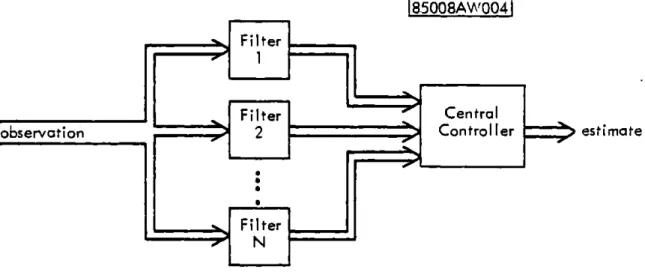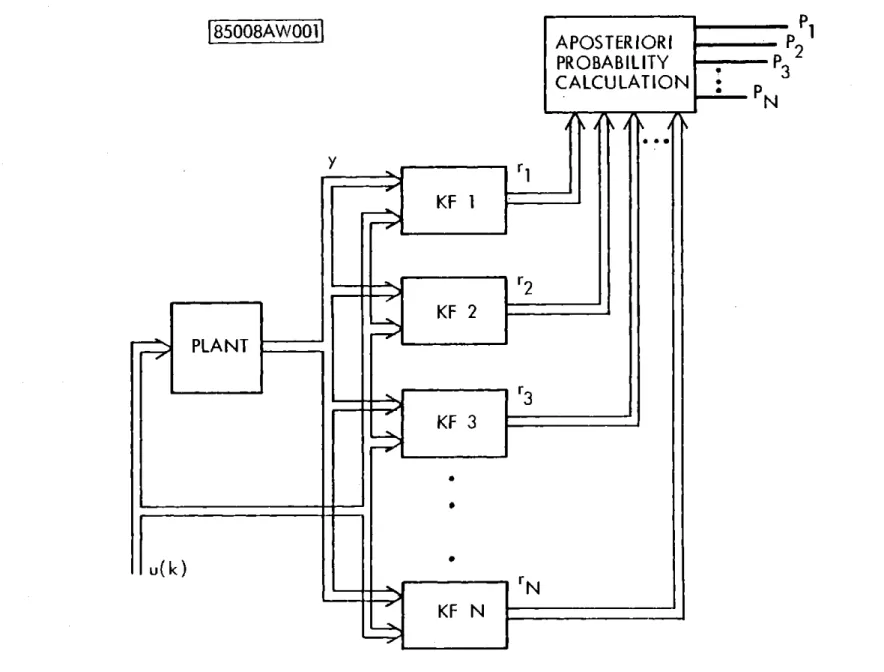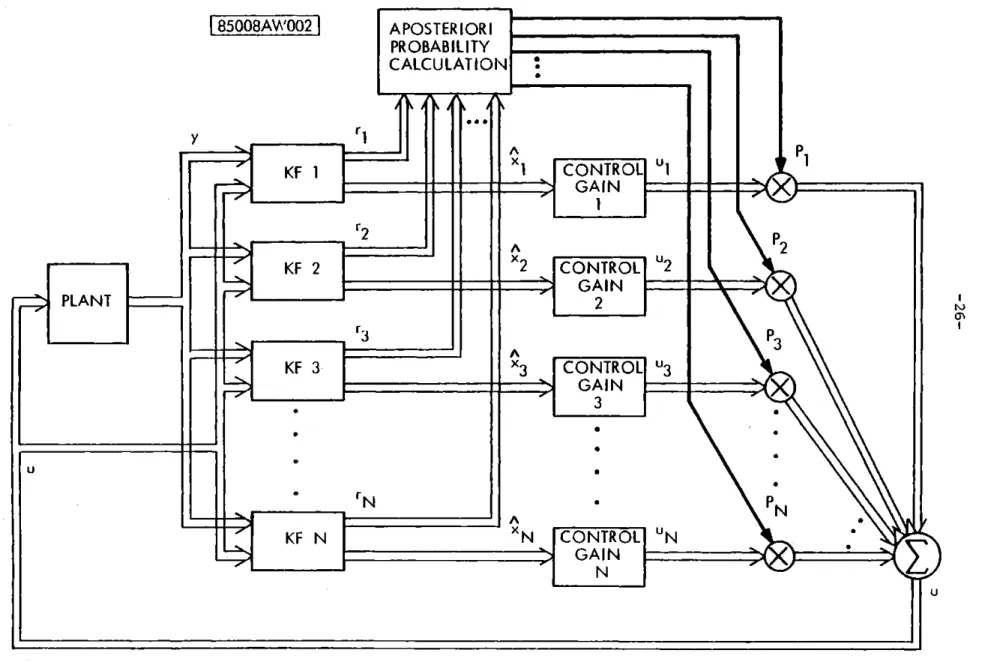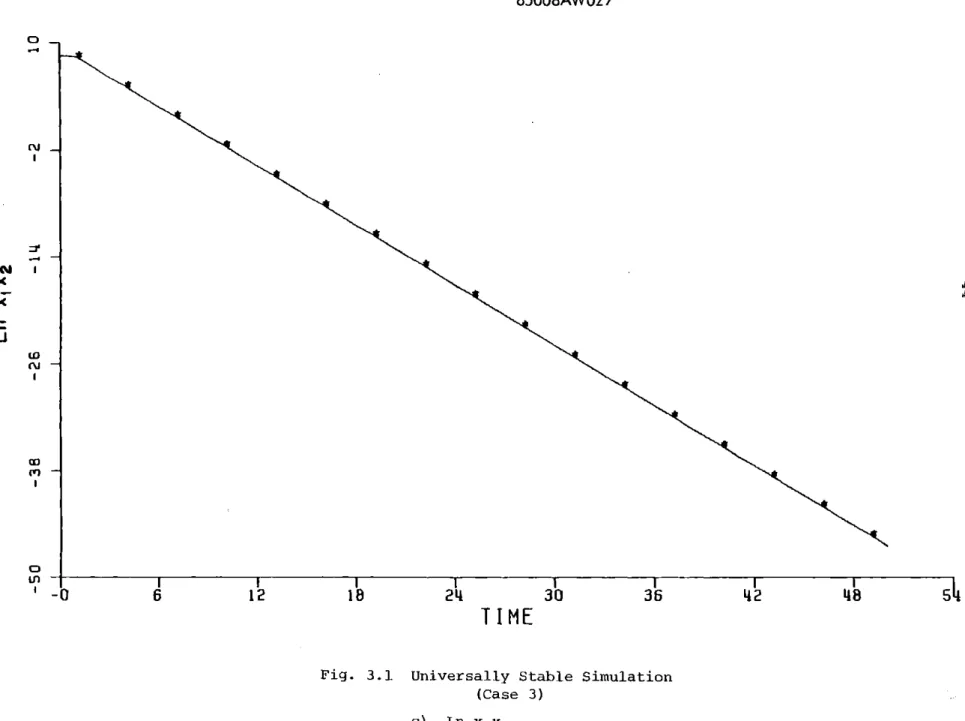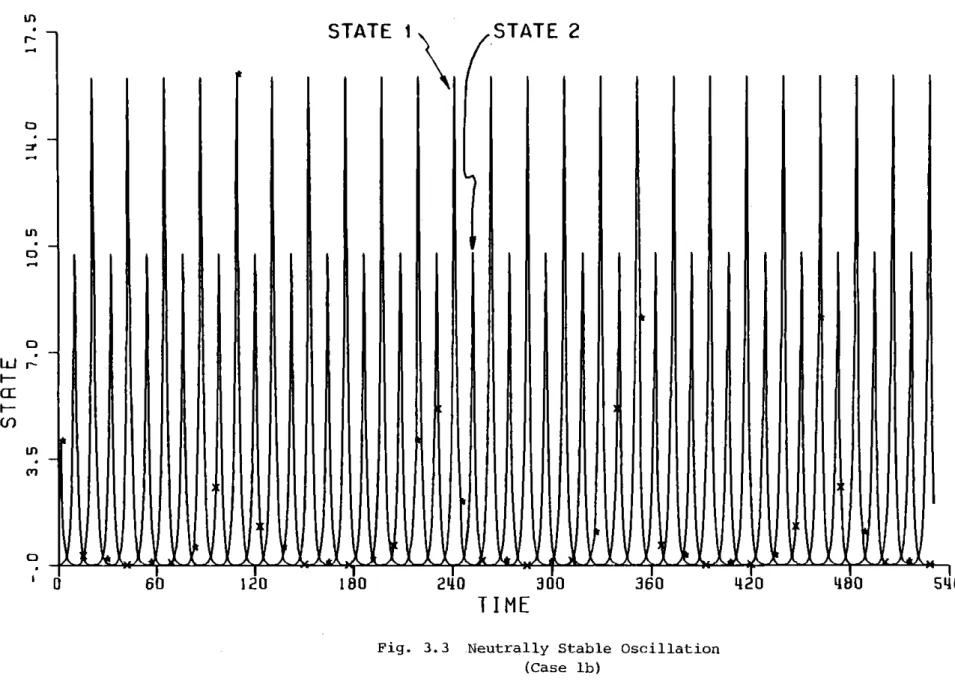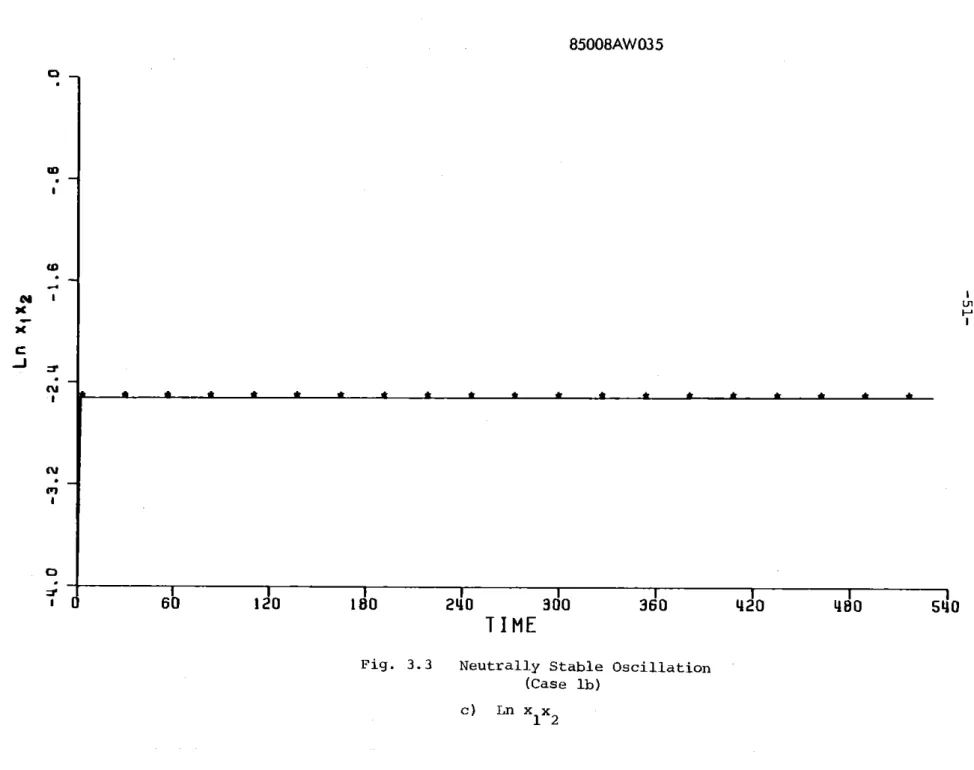AN ANALYSIS OF THE MULTIPLE MODEL ADAPTIVE CONTROL ALGORITHM
by
Christopher Storm Greene
B.S., University of Colorado
(1973)
S.M., Massachusetts Institute of Technology (1975)
E.E., Massachusetts Institute of Technology
(1976)
SUBMITTED IN PARTIAL FULFILLMENT OF THE REQUIREMENTS FOR THE DEGREE OF
DOCTOR OF PHILOSOPHY at the
MASSACHUSETTS INSTITUTE OF TECHNOLOGY August, 1978
MASSACHUSETTS INSTITUTE OF TECHNOLOGY, 1978
Signature
of Author . .0.C.f.
C.f.
... Department of Electrical Engineeringand Computer Science, August 29, 1978
Certified by...
... ,... Thesis
Supervisor
Accepted by... Chairman, Departmental Committee on Graduate Science
ADAPTIVE CONTROL ALGORITHM
by
Christopher Storm Greene
Submitted to the Department of Electrical Engineering and Computer
Science on August 29, 1978 in partial fulfillment of the requirements
for the Degree of Doctor of Philosophy.
ABSTRACT
The Multiple Model Adaptive Control algorithm has been used in
appli-cations of advanced control technology. However, in these applications,many undesirable characteristics of the method, such as high amplitude
limit cycles, have been uncovered.
In this thesis the basic types
of behavior exhibited by the method are explored.
This is done through
the simulation and analysis of the method as applied to a sample system
structure. This structure has been carefully chosen to exhibit the
major phenomena of interest while remaining amenable to detailed analysis.
Two major types of results are presented.
First of all, detailed conditions
for the existance of each of the types of behavior are developed for the
special system structure under consideration.
Of possibly greater
signi-ficance are the qualitative insights which result from extrapolating the
detailed conclusions to problems of more general structure. It is believed that the qualitative understandings developed in this thesis can form the
basis for the introduction of design modifications (two of which are
suggested in this thesis) and the development of a systematic methodology
for the design of adaptive control systems using the Multiple Model
Adaptive Control algorithms.
THESIS SUPERVISOR: Alan S. Willsky
TITLE: Associate Professor, Electrical Engineering and Computer Science
-2-ACKNOWLEDGEMENTS
I deeply appreciate the patient guidance and support provided by
Professor Alan S. Willsky throughout my career at M.I.T. in various
roles of counselor and thesis supervisor.
I have greatly enjoyed
working so closely with him.
I would also like to thank Prof. Gunter
Stein and Dr. Stanley B. Gershwin for their guidance and constructive
suggestions as thesis readers.
In addition, Prof-. Michael
Athans has provided considerable guidance and encouragement in the
preliminary phase of this endeavor.
Of course, many other people have aided me by discussing various
aspects of the problem.
A few of these are:
Mr. E.Y. Chow, Dr. J.
Douglas Birdwell, Dr. David Castanon, Dr. Paul K. Houpt and Prof. Nil!
R. Sandell.
I would also like to acknowledge the assistance I receiv(
from Ms. Margaret Flaherty in typing and from Mr. Arthur Giordani in
overseeing the production of the figures.
Finally, I would like to thank
my wife Sarah for her encouragemen
and patient understanding throughout the years of study.
Without her
this thesis would never have been completed.
This work was supported by the Office of Naval Research under
Grant N00014-77-C-0224 and by NASA Ames Research Center under Grant
NGL-22-OO9-124.
s
ed
Page ABSTRACT 2 ACKNOWLEDGEMENT 3 TABLE OF CONTENTS 4 LIST OF FIGURES 6 LIST OF TABLES 7 1. INTRODUCTION 8 1.1 Motivation
8
1.2 Background 101.3 Contributions of this Thesis 14
1.4 Overview of this Thesis 15
1.5 Notation 17
2. REVIEW OF THE MMAC METHOD 19
2.1 Maximum Aposteriori Probability (MAP) Identification 19
2.1.1 The Kalman Filter (KF) 19
2.1.2
Properties of the Kalman Filter
21
2.1.3
The Probability Equation
23
2.2 Adaptive Control 23
2.3 The Control Law 25
2.4 Comments on MMAC 27
2.5 Continuous Time MMAC 27
2.6 A Special Case 28
2.6.1 Discrete Time Case 28
2.6.2 Continuous Time Case 31
2.7
A Change of Variable
33
2.8
A
Useful Definition
34
3. QUALITATIVE RESULTS 36
3.1 Problem Formulation 36
I I -5-Page
3.2.1 Exponential Mode
41
3.2.2 Oscillatory Response
45
3.2.3 Mixed Case 56 3.3 Summary 58 4. STABILITY ANALYSIS 674.1 Linearized Analysis
71
4.2
Universal Stability
75
4.3 An Asymtotic Result 774.4 An Analysis of the Probability Equation 82 4.5 An Analysis of the Oscillatory Behavior 90
4.6 Quasi-Lyapunov Analysis 99
4.7 Domain of Attraction 108
4.8
Summary
117
5. NUMERICAL ASPECTS 121
5.1 The Lower Limit Effect 123
5.2 Forms of the Probability Equation 131
5.3 Proposed Implementation 133
5.4 Summary 136
6. COMMENTS AND CONCLUSIONS 139
6.1 Modifications to MMAC
140
6.1.1 Finite Memory MMAC. 141
6.1.2 Low Pass Filter 148
6.1.3 Miscellaneous Modifications 148
6.2 Summary of Results 158
6.3 Suggestions for Future Research 163
APPENDIX A 168
Page
1.1 Parallel-Adaptive Algorithm Structure 12
2.1
Identification Structure
24
2.2 Adaptive Control Structure 26
3.1 Universally Stable Simulation
42
3.2
Stable Oscillation
,
46
3.3 Neutrally Stable Oscillation 49
3.4 Unstable Oscillation 52
3.5
Phase-Plane Plot
57
3.6 Domain of Attraction - Large I.C. 59
3.7 Domain of Attraction - Small I.C. 62
4.1 Plot of P(-) vs.
a()
854.2 Switching Times 89
4.3 Typical Oscillation
94
4.4
Sketch of
A(P)
103
4.5
Regions of Decreasing
v(.)
106
4.6
Set of Equilibrium States
109
4.7 Stability Regions for A(P) 112
4.8 Set of Initial Conditions for Exponential Response 115
5.1 Effect of Limit on
a(o)
1255.2
Definition of T
1and T2
129
6.1 Simulation of Finite Memory MMAC 145
6.2
Simulation of Square-Root Modification of MMAC
150
6.3
Simulation of MMAC
with Scaled Residuals
155
-6-LIST OF TABLES
Page
3.1 Parameter of Sample Cases 40
3.2 Principle Modes of Response 65
4.1 Example of Range of 1 w(O)II2 for Exponential Behavior 116
5.1 Stability Summary - Probability Limited 137
INTRODUCTION
1.1
Motivation
In many applications
of
control theory, the dynamics
of
the plant
are incompletely known at best.
Furthermore, the dynamics are often
time-varying and non-linear.
In such an environment, control becomes a very
difficult task and the problem of the optimal control of such systems
remains unsolved. However, such systems need to be controlled and so
a myriad of suboptimal schemes have emerged.
The many methods which have been proposed can, in general, be
di-vided into two classes:
the passive methods which rely on the robustness
of a time-invariant feedback controller to maintain good performance and
the active methods which involve changing the controllers as necessary.
For example, much of the work of Horowitz [1,2] has been aimed at
de-riving a single, time-invariant control law which gives acceptable
be-havior for all plant parameter values (a passive approach). The work
of Wong [3, 4) has similarly been aimed at analyzing the robustness
properties of feedback controllers using a geometric approach, and
Safonov 15) has derived robustness conditions for controllers when the
parameter variations are due to a change in the operating point of anon-linear system.
It should be pointed out that the ad hoc approach of
increasing the plant noise design parameter (see Section 2.1) often
mentioned for the standard Linear-Quadratic-Gaussian (LQG) problem [6]
is also a passive method of overcoming plant uncertainty.
A major problem with such methods is that they are, by design, compromises. Performance for normal conditions is sacrificed in order
-8-
-9-to improve performance for other conditions. In the extreme, it may be
impossible to maintain the desired performance for the full range of
con-ditions using a fixed controller.
In contrast to the passive methods, the active methods make use of
a time-varying controller.
Thus, they employ mechanisms which force the
controller to adapt to changes in the operating environment. This, at
least in theory, improves performance under all operating conditions
since the controller can be tuned to the actual, rather than the average
or even worst case, conditions.
As previously mentioned, the optimal control of such systems is an
unsolved problem.
Thus ad hoc, suboptimal techniques have been proposed.
However, partly because of the non-linearities (due to adaption) of such
methods, they have not been subject to careful study regarding qualitative
performance characteristics such as deterministic stability. In
applica-tions, many of these methods have exhibited difficulties which have been
mitigated by further ad hoc modifications of the design 116, 231.
In
general, these modifications were not the product of extensive, systematic
analysis of the system's behavior and no general design methodology has
emerged.
The research which is reported herein attempts to qualitatively and
quantitatively examine the properties of one method of adaptive control
which has been discussed in the literature, namely, the Multiple Model
Adaptive Control (MMAC) method
17].
The MMAC method, which is discussedfurther in Chapter 2 of this thesis, has a very pleasing structure: a
cascade of something which resembles a Maximum Aposteriori Probability
(MAP) identifier [15] (basically a bank of Kalman Filters) and a bank of I I
linear quadratic regulators.
However, in use it has become clear that
the MMAC method can exhibit unacceptable behavior
-
such as high amplitude
limit cycles.
In this thesis the major qualitative properties of the
MMAC method are examined and the principle reasons for the unacceptable
behavior explored.
It is believed that a through understanding of the
behavior will lead to guidelines for the modification of the design
which will ultimately yield a general design methodology.
1.2
Background
The general area of adaptive control has received much attention
recently.
For example 126J and
[27
both contain numerous references
to
a wide variety of approaches.
The basic subject which is
addressed
is to generate a control u(t) for a system given by
x(t)
= A(_t).xCt)
+BCt
Iu(t)
+i(t)
with observations
t)I
=CtCt) xtt)
+nt t)
The state xCtl is an n-vector while the input u(t) is an m-vector and
zCt)
is a p-vector. The vectors Ct) and rj(t). represent systemun-certainties and observation noise respectively.
The condition which
introduces the most complexity is that the system matrix A (nxn), input
matrix B (nxm) and output matrix C (pxn) .are only incompletely known.
The performance measure which is often used to judge such systems is
I I
CO,
J(u) =
f
x' Ct)Q x(t)
+ u' (t)Ru (t)]dt0
where
Q
is an nxn positive semi-definite matrix and R is a mxm positive definite matrix.The solution to this control problem has not been found and the
work in [7] clearly indicates that the optimal system, assuming it can
be found, will prove to be far too complex to implement. Thus, numerous
suboptimal solutions have been proposed.
The MMAC method was largely inspired by the work of Magill [8] who
was the first to examine a parallel -adaptive estimation algorithm in
which the basic estimation is done by a bank of filters which are then
coordinated by a centralized controller (see Figure 1.1). Further work
in the area has been done by Lainiotis whose work has been summarized
in [9]. The major thrust of this work has been aimed at adaptive
esti-mation and parameter identification and not the control problem.
Many authors [10, 11, 7] have examined feedback controllers based
on the structure of Magill's estimator, however. For example, Stein
[10]
has been able to derive upper and lower bounds on the cost in the optimal control problem and using the upper bound, has obtained a controllaw exhibiting a parallel structure. Saridis and Dao 11] have
ex-ploited Stein's lower bound to obtain a different control law. One
major drawback of both algorithms is that they require significant
on-line computation.
Willner [7] proposed the MMAC algorithm as discussed in this
[85008AW4|I
Filter
observation
2
Jter
Con
tro
Ier
d-5estimateFilter
-13-upper and lower bounds of Stein. Independently, Deshpande et al [12]
arrived at the same algorithm as an ad hoc extension of the estimation/
identification algorithm of Magill [8]. The method has been further
considered by Lainiotis [13].
To our knowledge, no one has been successful in establishing any
definitive properties on the behavior of the MMAC method.
Specifically,
the convergence properties of the identification problem (i.e., with
the adaptive mechanism disabled) have only recently been proven. Both
Hawkes and Moore [141 and Baram [151 have provided useful results, but
both results do not hold in an adaptive situation (i.e., when the
con-trol law is a function of the system output).
The MMAC method has been applied to various settings. For example,
in Athans et al. [16, 231 the method has been used to control the F-8
aircraft. Also, the F-8 controller of Stein et al. [17] can also be
considered to be a multiple model design. Additional experience with
and insight into the MMAC method has been gained by applying the
esti-mation/identification algorithm to the detection of accidents on
free-ways
18].
To a great extent, the F-8 project 16, 23] has provided the
moti-vation for our work. In that project, where the true system does not
correspond exactly to any of the hypothesized models, several problems
were encountered. First of all, the probabilities often oscillated
rapidly between two models, exhibiting behavior very much like a limit
cycle. This problem led to a design modification consisting of the
A second problem which was encountered involved the choice of which
models to include in the set of possible models.
The aircraft, of course,
responds in a continuous way to parameter changes, and model set selection
was found to have a considerable effect on performance.
It is issues such as these which have motivated our study.
Our
goals have been to understand the characteristics of the MMAC method
and develop a useful design methodology based on the MMAC algorithm.
1.3 Contributions of This Thesis
This thesis presents the results of a detailed study of the MMAC
algorithm.
The major conclusions of this study, which are detailed in
Chapter 6, are of two basic types. First of all, there are specific
conclusions which the analysis of Chapters 4 and 5 yield.
However,
since the analysis of these chapters relies heavily on a special case,
the results are of relatively little direct applicability.
However,
they are indicative of the types of and basic causes for behavior which
has been observed in more general situations.
Thus, of possibly greater
importance are the qualitative conclusions which result when the specific conclusions are extrapolated to general problem structures. Thesequalitative results are also detailed in Chapter 6.
The following are the major results of this thesis.
1.
The neutral stability of the MMAC method is established.
2. Conditions which guarantee state convergence are derived.
3. The MMAC algorithm consists of a bank of Kalman Filters,
I I
-15-the system generating -15-the observations (referred to as -15-the true system).
The outputs of each filter are used to calculate the aposteriori
prob-ability that each filter matches the true system. The feedback control
is then given-by the probabilisticly weighted average of the controls
calculated for each hypothesized model. (See Chapter 2 for a complete
discussion). This results in a highly non-linear closed loop system.
However, if the probability is constrained to be constant, then the
closed loop system becomes linear time-invariant. In this thesis it
is shown that even if the closed loop system is unstable for all
constant values of the probability, the overall system may have a
bounded (in fact "hyperbolicly stable" - see Section 4.6) response.
For a special case, specific conditions are derived.
4.
The effects of numerical roundoff are examined and a form of
implementation which behaves well is proposed,
5. The specific results of this thesis can be used to predict the qualitative behavior of MMAC systems which have a more complex structure
than the ones analyzed herein.
4.1 Overview of this Thesis
In Chapter 2, the MMAC algorithm is introduced in the form which
will be used in the reaminder of this thesis. Both the continuous and
discrete time versions of the algorithm are presented, although the
discrete version is employed for the majority of the analysis.
In Chapter 3, the canonical problem which forms the focus for the
situation which retains many of the qualitative properties (such as the
existence of oscillations) which have been observed in more general
problems while simultaneously being amenable to detailed analysis.
The
remainder of the chapter contains a discussion of the various types of
behavior which have been observed in simulations of the canonical problem
along with sample simulation results to illustrate each behavior. The
basic responses are shown to be of three types. In the first, termed
"exponential" or "geometric", the states are geometrically stable.
In
this case, all of the states are decreasing- for all constant valuesof the
probability.
The second type termed "oscillatory" results in the
probability
oscillating between zero and one, which in turn results in
the states exhibiting an oscillatory behavior, alternately increasing
and decreasing along with the probability.
The third type termed
"mixed", results in a behavior which, depending on the magnitude of the
initial conditions, exhibits either an oscillatory or exponential
behavior.
These simulations have been used to motivate the analysis
in the remainder of the thesis.
Chapter 4 contains the majority of the analysis of the MMAC method.
In this chapter, each type of behavior described in Chapter 3 is analyzed
in order to yield an understanding of the underlying causes of the
behavior.
This results in conditions which guarantee the existance of
the exponential mode, Furthermore, various approximations are used to characterize the major modes of behavior which lead to conditions for-17-canonical problem. Beyond this, more general qualitative results are
also presented.
In Chapter 5, various aspects of the problem of implementing the
MMAC method using a digital computer are discussed. By far the most
important of these is the modification to the analysis of the
oscilla-tory behavior when the finite precision nature of the computer becomes
a factor in the behavior. Also discussed are the effects of using
each of the various forms of the equations as far as numerical accuracy
is concerned. The chapter concludes with the proposal of a new form
of the equations which is believed to allow the designer greater latitude
in design without encountering numerical problems.
Chapter 6 contains a discussion of various ad hoc design
modifica-tions which have been proposed in order to overcome the shortcomings of
the MMAC method. Also included there is a summary of the conclusions
of this thesis as well as some suggestions for future research.
1.5 Notation
The following is a brief list of the notation employed in the
thesis. Except for the notation for the components of the residual
of a Kalman Filter, all are believed to be standard.
Mvatrices are represented by upper case letters which are underlined.
Vectors are represented by lower case letters which are underlined.
Scalars are represented by lower case letters (not under-lined).
A' - the transpose of A.
A - the norm of a matrix = Max X(A'A)
X (A) - the set of eigenvalues of a matrix.
N(A) - the Null Space of a matrix.
I
1
-1
xi
-
the
6-norm of a vector x given by
/'
C1x
for
C51positive definite.
xjj
- the norm of a vector given byA U
a - magnitude of a real or complex a.Ax(k)
-change
inx(-)
from k-1 to k.N
IT
- Product for i=l to Ni=J-N
- Sum for i = 1 to
N
i=1
x
-vector
of true state variablesX.
- scalar true state component i(j) .th
r. - scalar 3- component of r. (a,b) - open interval between a and b. [a,b] - closed interval between a and b.
CHAPTER 2
REVIEW OF THE MMAC METHOD
The purpose of the present chapter is to introduce the Multiple
Model Adaptive Control (MMAC) algorithm. A full discussion will not begiven as that is available from other sources
(7,
121.
The MMAC algorithm is composed of two parts. The first, which performs an estimation/identification function, is similar to a Maximum
Aposteriori Probability (MAP) algorithm (151 which is discussed in Section
2.1 for the discrete time case. The MAP algorithm is structured as a bank of Kalman Filters with some decision logic. The second part, whichis cascaded with the MAP-like algorithm, is a control computation 'which
is discussed in Sections 2.2 and 2.3 for the discrete time case.
The remaining sections of this chapter contain a development
and discussion of the special forms of the equations for the MMAC algorithm which prove useful in the remaining chapters of this thesis.
2.1 Maximum Aposteriori Probability (MAP) Identification 2.1.1 The Kalman Filter (KF)
Assume that a linear, time-invariant (LTI) discrete time system is
given by:
x(k+1) = A x(k) +
Bu-lk)
+C(k)
(2.la)with observations:
y(k) = Cx
(k)
+ n(k) (2.1b)-19-
-20-where x(k) is the n-dimensional state vector, u(k) is the m-dimensional
control vector and y(k) is the p-dimensional observation vector. The
noise sources 4(k) and T(k) are taken to be zero mean white Gaussian
noises of covariances E and $ respectively. The matrices A (nxn), B
(nxm), and C (pxn) are the system, input and output matrices respectively. We will use the notation
(A, B, C) (2.2)
to refer to the above system. The system (A, B, C) which generates the
observations y(k) will be called the true system.
In practice, the actual values of the matrices A, B, C, E and
4
are unknown. However, estimates of these parameters are often available froma knowledge of the system. Thus,, (A. , B. , C. ) will be used to denote th
the i model of the system, given by:
x(k+l) = A.x(k) + B.u(k) +
(k)
(2.3)
y_(k) =
C
x(k) +n(k)
For the purposes of the present study the values of $ and E will not vary from model to model, although extensions to that case could be
con-sidered.
It is well known that the steady state Kalman Filter (KF) [19, 20]
which estimates the state x(k), based on the model
(A. , B. , C.)
-21-i.
(k+l) = A.W. (k) + B.u(k) +H.
r. (k+l)(2.4) r(k+l) =
y(k+l)
- C. [A.i.(k)
+ B.u(k)]th
where H. is the Kalman gain for the i- model: -2-.
=
.C
V
(2.5)
and Z. is the nxn solution to the familar Riccati equation
-- t
-1-E=
[Cjt
c.
+(~A
j
..
+=)
I
.(2.6)
The state estimate
i. C)
is n-dimensional, while the residual vector,-2.
r.
C(-),
is p-dimensional.2.1.2
Properties of the Kalman Filter
The Kalman Filter has many interesting properties, (see for example
[19]), a few of which are useful in understanding the MMAC method. These
are now discussed.
A few definitions are useful.
Definition 1:
The
th
Kalman
Filter is said to be matched if the matrices
used in the filter design (i.e., the model) and the matrices of the true
system are identical; that is, if A. = A B. = B and C. = C.
Definition 2: The Filter is called mismatched if it is not matched.
th
Property 1:
If the i
Kalman Filter is matched then in steady state:
E{r. (W)1
=0
(2.7a)
-22-where
6(.)
is the impulse function, E{-} denotes expectation, and 6. isgiven by
6
+=4iCE
C,
.(2.7c)th
Furthermore, if the i filter is matched, then
i^C.()
gives the optimal estimate of the state x().Property 2: If the ith Kalman Filter is matched, then the probability
density function for the residual r.(-) is given by [20]:
-1- [5r.'. r]
p(r.)
=5.e
2
i-(2.8a)with
=
((2
)m
.(2.8b)
Property 3: If the ith Kalman Filter is mismatched then
Ejr. (k)
}
= r. (k) (2.9a)-1-t
-Ef(r.
(k) - r. (k))6. (r.(i)
- r.(i))
'} =(k-t)
(2.9b)where r in general is nonzero and 0. is a function of the system and the
noise covariances (see [28]) with, in general, 0. (0) > I.
It follows that if two filters (one matched and one mismatched) are
computed then
1
-1
E
Ok)e
r
I
())
<E{r;(k) r2
2(k)}
(2.10)
-23-[16]. Thus, if equation (2.8) is evaluated for both a matched (1) and
a mismatched (2) KF, then
E p(r%)I
>Efp(r
)}
-(2.11)
2.1.3 The Probability Equation
Assume that we are interested in identifying a dynamic system from
its outputs and that the true system is known only to be one of N
speci-fied models.
Baye's rule and Properties 1-3 imply [15, 7] that the
th
probability that the i model matches the unknown system (P.) is given
by
P.(k) p(r.(k+l)) P(k+l) =N.(2.12)
3.NE
P. (k)p(r. (k+))j=1
where p (r.(k+l)) is given by equation (2.8). The structure of the
re-sulting system is shown in Figure 2.1.
2.2 Adaptive Control
If one knew with certainty which model matched the true system, it
would be a simple matter to design a controller using any of the standard
synthesis techniques. Therefore, one reasonable way to determine a control law for the unknown system is to probabilisticly weight the con-trols which would be used if one assumed that one of the models was correct. That is, let
N
u(k) =
2
P. (k)u. (k) (2.13)PLANT
PROBABILITY
CALCULATION
S
N
r3
KF3
r
Ll
KF 3
Fig. 2.1 Identification Structure
"3
-25-where P. (k) is given by equation (2.12) and u. (k) is the control which one would apply if model i were assumed to be matched to the true system.
It will be assumed that
u.
=G.X."(2.14)
although this is not necessary and is further discussed in Section 2.3.
Figure 2.2 thus summarizes the Multiple Model Adaptive Control method.
2.3 The Control Law
The MMAC method as developed in the literature [7, 16) has assumed
that the linear quadratic (LQ) methodology is used to design the controller.
Thus, the feedback gains G. of equation (2.14) are chosen to minimize
-J(u)
=2 (x'(k)Ox(k)
+u' (k)R
u
(k))
.(2.15)
k=J
It can be shown [211 that the optimal gains are given by
G. = [B!K.B. + RI
1
B'K.A.
(2.16)where K. is the solution to the steady state Riccati equation
K.
=Q.
+ A'K.A. - A!K..B, [B!K.B. + RI B..K,A.(2.17)
Although to date, all references to MMAC have made use of the control
law (2.16), this is not a necessary part of the method. Thus, any control
law which gives good results for the respective model may be used.
How-ever, there is a strong interaction between control law choice and
PLANT
U1
PROBABILITY
CALCULATION
y
rKF 1I1
r2A
KF 2
2N
-
3-x
r3N
KF N
xN
P1
CONTROL
u2
G AIN
P
u2
CONTROL
2
GAIN
2
1
3
CONTROL
u3GAIN
x
31
N
[CONTROL
N
GA N
Fig. 2.2 Adaptive Control Structure
For the purposes of this study we will for the most part restrict our
research to control laws based on the linear quadratic (Equation 2.15)
form.
2.4 Comments on MMAC
A few comments are in order.
1)
The MMAC algorithm, as shown by Willner
f7]
is suboptimal even
for the problem originally posed. Willner was able to show that the
algorithm is optimal for the final step of the dynamic programming algorithm [7] but was unable to continue the calculation backward in time.
2) As posed above, the true model is assumed to belong to a finite set of known models. Lainiotis
[9,
13] has discussed the infinite set case but concludes that a finite approximation is then required for usein applications. Thus, for most real problems when the true model may
take values from an infinite set, a further suboptimal approximation is
required.
The results of Baram
[15]
(which. apply only to the open-loop
case) may help in discretizing the model set.
2.5 Continuous Time MMAC
As. developed in the preceeding sections, the MMAC method has been based on discrete time systems. For analysis purposes, it will be useful
to consider the related continuous time problem, largely because of the
simplified form of the probability equation.
The complete equations for the method will not be given here. as they are the continuous time regulator and continuous time Kalman Filter
Dunn [22] has shown that if P. (t) is the probability of the it model at time t then
N N
-.
-K1
P.
1.
Ct)
=P.
1
(C.i.
-E
P.C.SU)G
(y -(P.C.2.)
(2.18)
1-1=r
-3-3j=lJ3
where C.,
x.
and y are defined analogously to
the discrete time case and
6 is the observation noise covariance.
The property which makes Equation
(2.18) useful for analysis is the absence of either exponentials or a
denominator.
These equations are examined further in the two model, two
state case in the following section.
2.6 A Special Case
Of special interest to the (i.e., the two model case) with shall assume that the input (B)
The special case capturesa
we are interested in examining A
it forms the central focus for t
research at hand is the case when N=2
full state observation.
Furthermore,
we
matrix is the identity.
all essential features of the problem that
without adding unnecessary complexity, and
this research.
2.6.1 Discrete Time Case
In the discrete time case, the true system is then given by
x(k+l)
=Ax
(k) + u(k) + ;_(k)(2.
19a)
yk)
=x(k)
+ _(k)with models
Model1:
i
(k+l) = A R (k) + u(k) +C
c)
-1
-1--1-y(k)
=2
(kc)
+r~k)
-_ -l -_ (2. 19b)-29-Model
2:
2^
(k+l)
=A
i(2k>
+uk)
+C2k
-2
_(2-2-2
.l9c)
y (k) = 2(k) +
r(k).
Thus, the MMAC method reduces to the following set of discrete time
equations
x
(k+l) =Ax
(k) + u(k) +C
(k) y(k) =x(k)
+c(k)
(k+l) =A2
(k) + u(k) +H r
(k+l) (k+l) =y(k+l) -A k) - u (k)2
(k+1) =A2
(k) +u(k)
+ H r (k+l) (2.20)-2z-2-2
2-E2
2 (k+l) = y (k+1) -A2
(Ik)
-u(k)
u (k)
=-Pc2
(k)
-P2
c2
(k)
-11-12-2z-2
P (k) p(P
(k+l) 11
P
1(k)
p
(r
1)
+P
2(k)
p
(
2)
-fr.1
r.P(r )
fSe
The major goal of the research has been to understand such qualitative
properties of the MMAC method as stability. Since the phenomenon which
have been observed are largely due to the nonlinearities of the system
and occur even in noise-free simulations, the noise terms
C(-)
and T(.) add an unnecessary complexity. Thus, these terms are ignored in theassuming the noises to be present, are. an integral part of the MMAC method and are therefore retained. Thus, the principle focus of the work is to examine the deterministic properties of Equation (2.20) and the correspond-ing continuous time system discussed in the next subsection. Since the
sum of the probabilities of the models
must
always be 1, it
is known that
P2(k) = (1-P 1(k))
Vk.
Then, rewriting Equation (2.20) in terms of the residual r (k) we see
that the equations of the MMAC method can be summarized by
x(k+l) = Ax
(k)
+ uk)r (k+1) = (A-A )x(k) + A
(I-H
)r(k)
E2 (k+l) = (A-A2)x(k) + A(--2
)r(k)
(2.21)
--2
-(-2--21-u(k)
=-(P G
+ (1-P)G
-(k) + PG (I-H r
+Cl-P G
(I-H)r
S1-11
-2--t
- -2
-2-2
P
1Ck) p(r
1)
P (k+)
P1=1(
P(k) p() + (1-P (k))p1
-l
1
-1
-1
- - [r6 r.) p(r.) =S.e
It will be useful notationally to combine the state and residual
equations into one vector equation. Therefore, we define the vector
w
(k) = [x (k), r'C(k) , r'2(k)]' .-31-A-PG
-C-P)G
PG(I-H)C(1-P)G (I-H)
-a, - U 1)-2 :1-1 -- : 1) -2 I -- 2 (2.22b) ... a... ... w(k+(A-A) A(I-H)
0
w(k)...
...
...
(A-A) 0 -2 A(-2 or w(k+l) = i(P )w(k) withP
(k)p~
P (k+1)= (2.22b)1(Pk(k))p(=)
) + (1-P(k))p(r2)These equations, along with their continuous time counterparts, form the
basis for the research which has been undertaken.
2.6.2 Continuous Time Case
Similar assumptions to those previously presented for the discrete
time case can be made in the continuous time case. Here, we will again restrict our attention to the two model, state feedback case with B=I. Thus, the MMAC method reduces to the following equationsiC(t)
= Ax (t) + u(t) + C(t) y(t) = r(t) + 1(t)E
(t)
= A 2(t)
+ u(.t) + HrWCt)
(2.23)
r (t) = y(t) - x (t)-1
-
-1
2(t) = A 2 (t) + uCt) +H
2(t)-2
-2-z2--r2t)
= y(t) - ^2(t)1-2
-2
u
t)
= -P1G ( t) - Pt)
1 iz-
2 -22 2*2 (
1
p(t)=
P1 (t)P2(t)Ii
1
(t)-i (t)J'[x-P1 (t)i-(-PC1
(t))2
Ct)]
with P2 (t) = 1-P1(t).
For the
same
reasons as presented in the previous section the noisesources _(t) and _(t) will again be ignored for the majority of the
proposed research. It should be noted that under this condition, the
residual r.(t) exactly equals the estimation error x(t) - x.(t). Thus,
equations (2.23) can be rewritten as
5(t)
=Ax
(t) + u(t) (t) =A -H )r(t) + (A-A )x(t) (2.24) L2(t) = (A-H )r2(t) + (A-A )x(t)-2:-2
z-2 :-2
--- 2
u(t) = -P (t)G(x(t)
-(t))
- (1-P (t))G
(x(t) - r (t)) - 1-1-
-11
--2
P (t) = P1(t) El-P1(t)] Er2(t) -1(t)]'
0
1EP
(t)1(t)
+ (1-P (t))r (t)]Thus, if we again combine equations by defining the variable
x(t)
w(t)= r(t)r (t) E2 -2t(r
-33-PGA
-Cl-p
(A - 2(A-A)"AH
1=2--1
12
0
-2
2
w
(t)
(2.25a)
or
with.w(t)
--
= A-P,i(P )w~t)
-(-,
(2.
25b)
-K'
P Ct)
=P
(t) [1-P (t)1)r2(t) -r
(t)][p
(t)r (t) + (1-P(t))r2(t)] 11=1-2
-1
-l1
"z-22.7
A Change of Variable
A change of variable which proves useful in the sequel is to let
(2.26)
q = 2P1 -1Making this change in Equation (2.22) yields
w(k+1) =
A(q)
w(k)(1+q)p(Er)
-(1-q)p(r
2(l+q)p(r
1)
+(1-q) p
(r
2where
(2.27)
1
1
A_--L
A -A2
I'(1+q)G
(-)
- )In continuous time the corresponding change to Equation (2.25) yields
EA
w'(t) =
_(q) =
(A-q)
where
w(t)
=(q)
w
(t)
4t(t)
= -(-q2)r-r'6
(l+q)r
1 +(1-q)r
2]
1
1
..
A- (+q)G
1-
(.l-q).G
2j.(l+q-)G
2 2 (q)=(2.28)
--
2.-.A-
2
Note that the same basic notation is used for the A matrices of Equations (2.22), (2.25), (2.27) and (2.28). However', no confusion should arise as the meaning should always be clear from context.
2.8 A Useful Definition
A further concept which will prove useful can be seen by considering either the continuous or discrete time problems as summarized by either Equation (2.25) or (2.22)
Continuous
time:
w
(t)
= Ai()w(t)
-t
-1
-Discrete time:
w(k+l)
=A(P )w(k)
-
-l-
(2.25)-(2.22)
where
Continous time:
Discretetime.;
A-.PG -a,-a1-p
1-1
1)G2
1-2
A A A- A - -2 A- AA- A
--- 2
A-
' -0 A) (aH P12 AIH) (-H - -- 2 -)2(-35-Thus, it is clear that if P
(-)
is held constant, then Equations (2.25)and (2.22) describe linear, time-invariant dynamical systems in the
variable w' = [x', r', r']'. Thus, Equations (2.25) and (2.22) with
- - -1 -2
P constant will be referred to as the linear, time invariant system for fixed P, or LTI for fixed P. As will be seen in Chapters 4 and 5, many of the major properties of the MMAC method can be expressed in terms of
the properties of the LTI system for fixed P as a function of P. A second important point to note is that in applications and simulations of the MMAC system, another parameter becomes important due to the finite precision usually available for computation. From the equations of this chapter, it is clear that the MMAC method has the
property that
P. (k) 0= -P. C-) = 0 for all future times.
1 1
Such a situation is usually to be avoided, as it
reduces the flexibility
of the algorithm in a number of applications.
For example, the parameter
of the true model are often changing in adaptive control situations, and one would like to require P. to be nonzero for all time so that the MMAC algorithm can respond to such changes. Thus, one almost always: appliesan additional constraint on the probability such as
P. Ck)
>P
.i
, k.1 - .lim
-50
This has been done throughout this study with a value of Plim =10 The effect of such a limit is examined in detail in Section 5.1.QUALITATIVE RESULTS
In order to guide and motivate the research, we have examined a problem consisting of a system with two independent states and two models.
This
system, while simple, captures many of the basic issues which are
important to the method and sheds light on the fundamental problems
in-volved with the MMAC design. The problem is formulated in the nextsection of this chapter. The remaining sections contain simulations
which demonstrate the various types of behavior which have been observed.
A discussion of the important properties is included.
3.1 Problem Formulation
In most applications, of an adaptive control algorithm, a detailed
analysis of the behavior of the algorithm has proved intractable. This
is especially true for the MMAC algorithm.
However, in the case of
MMAC,
it
is possible to find a simple example problem that lends itself
to analysis and simultaneously maintains the basic properties exhibitedin simulations of the more general systems.
Thus, for the purposes of
this thesis, a sample problem structure has been chosen which displays
what we feel are the critical characteristics of the method and which
is also amenable to detailed analysis.
The chosen true system to be controlled is given by:
a 0
x_(k+1) = x (k) + u(k) +
rVk)
(3.1)0
aL (k) =x (k) + -n.k)
-36-
-37-or a continuous time system of the same structure and A matrix
a
0
(t) =
[
]x(t)
+
u(t)
+ (t)Lt
a
y_(t) = (t) + TI(t)where a takes on values in the range [0,
21.
The discrete
is useful for simulation studies and most of the analysis.
of the continuous time system provides greater insight for
tion results in Section 4.1.
The set of models for either
or continuous time case is given by
Model
1:
(A,1, I) Model 2: (A,2 , I)with
time system
However, use the lineariza-the discrete A0
:i
A2
:i
where
i
takes on various values from 0 to 1.5.
The parameters a and
i
are varied to obtain different responses from the overall system.
For the purposes of
KF
design, the noise sources
(-) and n(-) are
assumed to be zero mean, white and Gaussian with covariances of I&(-)
where I is the 2x2 identity matrix.
This structure results in diagonal
Kalman Gain matrices such that
h
0
LO
h
(3.2)
I Ih
0
LO
hj
's
where h is the gain corresponding to a and h is the gain corresponding
to
a.
Further, the control law weight
and R, are chosen diagonal such
that
R R =I-l
-2
-q 0 q0-21=11
:i22[
.]
[ qI 0 q_This results in a diagonal control gain matrix
g9 0 J
0-G =G =.
0 g 0 g
The structure described above
will
be referred to as the canonical problem.
The emphasis of this study has been on the examination of such
quali-tative properties as stability.
Thus, we ignore the noise sources both
in the simulation and in the analysis of the properties of the MMAC
method.
That is, in both the analysis and simulations, C(-) and Tr(-)
are
set equal to zero. Note, however, that theKF's
designed with the assumed non-zero noise sources are retained. It is clear that noise can havea major effect on a system [29].
However, as we will see, many of the
properties of the MMAC method are due to the nonlinearities of the
probability equation.
Thus, it
is our feeling that an anlysis of this
noise-free case is of considerable importance.A few comments are in order concerning the the choice of the example problem. First of all, the system is chosen to be the simplest possible
.I I
-39-state, two model system. The choice of model is, admittedly, somewhat
extreme in the degree of symmetry and mismatch between the models and
the true system. However, this choice has been deliberately made in order
to investigate phenomena which have been observed in actual applications
123].
Thus, it is felt that the analysis of this problem has yielded
insight into the more general case.
3.2 Basic Responses
Various types of responses have been observed in simulations of the
system presented in Section 3.1. Table 3.1 details the parameters used
for each simulation. The remainder of this chapter presents examples
of each of the major modes along with a discussion of the important
characteristics of each. The simulations, which have been performed on
an IBM 370 computer using double precision FORTRAN, have been used to
motivate and guide the analysis of Chapters 4 and 5.
In fact, the types
of analysis described in these chapters and, in particular in Section
4.6, were to a large degree suggested by the simulations discussed in
this chapter.
For each simulation presented, three plots have been included. The
first is a plot of the probability of model one (P1) versus time. The
second is a plot of the two true states x1 and x2 versus time. The third
is a plot of the quantity ln(x1x2). This quantity has been found to be
indicative of the stability of the closed loop, nonlinear system. This
variable is further discussed in Section 4.6 where it is linked with
Case
#
la
lb
lc
2
3
a
a
2 22
1.5
.9
0
0
0
1.0
0
q
g
g
h
Ii
Figures
1.02
0--*
1
1
1.62
1.5
1.4
1.09
.538
1
1
1
1
1
0
0
0
.618
0
.809
.809
.809
.7245
.597
.5
.5
.5
.62
.5
TABLE 3.1Parameters of Sample Cases
*This value of the control can not result from an LQ design. 3.2
3.3
3.4
3.5,6
3.1
I I .
-41-3.2.1 Exponential Mode
The first type of behavior is one in which the states of the true
system increase or decrease in an exponential manner (see Figure 3.1).
This type of behavior appears to arise in two situations. First,
examination of the equations of Chapter 2 indicate that if the KF
resi-duals r1and r2 are equal with the true state components equal to each
other, then P t) = 0 or equivalently, PC(k+l) = P (k). Thus, if the system is symmetrically initialized (that is, the two true states are
equal with
rl
=r2
=0
and P1 (0) = .5) then P1(t) = .5Vt
or equivalently P (k) = .5 V k. The closed loop system is then time invariant and sta-bility analysis for the resulting LTI system follows as usual. Note thatthe resulting system can be exponentially stable, neutrally stable or
exponentially unstable depending on the control gains G and G .
Al--l
-2
though this is clearly a singular condition, it nonetheless is important
from an applications point of view because one commonly attempts to
initialize the system with equal probability and with rl = r2 (i.e., x 2=). An analysis of this mode is presented in Section 4.1.
A somewhat similar type of behavior occurs when the LTI system for fixed P is stable for all P. This, of course, is a fairly restrictive
condition which in essence requires extreme robustness of each controller.
However, such a condition does imply exponential stability. This occurs
in-dependently of how the probability behaves. Note that this is a
non-trivial result since A(P(k)) is time-varying because P(k) is. Section
4.2 contains the analysis of this situation and Figure 3.1 is an example
is
24
30
T I ME
Fig. 3.1 Universally Stable Simulation (Case 3) a) Probability of Model 1
36
0 M~ 0 CE)-J
LUI
C
F-cc
C
. C: CU 0 M'Li
-o
6
12
42
48
SI4
I 69t) .fir & 46 46 Aw 4685008AW026
M-
STATE I
cr-
STATE 2
(n -06 12 18 24 30 36 42 48Fig. 3.1 Universally Stable Simulation (Case 3)
M
('A
I x CD (i-06
12
18
24
30
36
42
48
Fig. 3.1 Universally Stable Simulation (Case 3)
-45-3.2.2 Oscillatory Reponse
Probably the most unusual behavior which has been observed both in
the current work and in applications of the MMAC algorithm (23] has been
an oscillatory response in which the probability jumps between
near-zero and near-one* in what appears to be (but strictly speaking is not)
a limit cycle.
Figures 3.2 through 3.4 are examples of this type of behavior.
Figure
3.2 is a case in which thepeaks
of the state trajectories areapproxi-mately constant while the period of oscillation increases.
Figure 3.3
is a case in which both the peaks and the period are constant while in
Figure 3.4, the system is unstable,
These three cases are obtainad by
changing the value of the control gain. Note that each gain would yield
stable behavior for the model used in its design.
It is interesting to note that the states of the system are also
highly oscillatory,
It might be expected that the plant dynamics would
smooth the rapid probability transitions to form a smoother "average"
state response. However, as shown in Chapter 4, the oscillatory state
behavior is a direct consequence of the model mismatch problem in the
MMAC algorithm.
The reasons for this oscillatory behavior, which are discussed in
Sections 4.4 through 4.6 and again in Section 5.1, are closely related
to the fact that neither of the hypothesized models individually yields
*This is the one set of simulations in which the lower limit on the probability (.see Section 2.8) of 10-50 is achieved. Section 5.1 dis-cusses the analysis in this case in detail.
-
~
-
.
.L 4 W'- --- d,---4 - iA - I ____1______________ 6240
TI
ME
300
360
Fig. 3.2 Stable Oscillation (Case
la)
a)
Probability of Model 1
0 0 0D OL t * -iLui
0
CC
L I:)cc:
CL
0 CD-0 flu-0 (V 0I
60
180
420
480
540
* I& dr AL-46 .A6Ah-120
85008AW032
STATE 1
akr i
IWSTATE
.2
% . vaa- %,a I& M.- -
J
-~ -~ -~ ~1 - :r.--:~ -- 1 -.I ~ -- - -I- -~- I
240
300
360
TI ME
Fig. 3.2 Stable Oscillation (Case
la)
b) True StatesLn
0LLu
F
-09
In
040
AU
V
Ait
Y
41
60
120
2
180
420
ka480
540
WAC O ('1-V 0 60 120 180 240 300 360 420 480 540
T I
M
E
Fig. 3,2 Stable oscillation
(Case la)
c)
85008AW034
0 CcCL
rC-b~
0.
ILUL II U J-LLH ALI HILI-4L 1. J11.1 JI III
360
Ai
4 1 I
420
480
S54O
Fig. 3.3 Neutrally Stable Oscillation (Case lb) a) Probability of Model 1
r-4
HHn
I I I300
T
I
M E
I0663
120
180
240
STATE
I
STATE 2
t
-I-. -- -- -~
V
240
30
360
TI
M E
Fig. 3.3 Neutrally Stable Oscillation (Case lb)
b)
True States
0 Lfl 0 0LuI
F-a:
F-WI
00
60
120
180
0iLID
420
'iao
WC4U'l
I85008AW035
H a A * a * * * * a A a.6 * a a A300
T I M E
Fig. 3.3 Neutrally Stable (Case lb)
c)
Ln
x12
Oscillation
09-0 31C CD I CV C'? 0-r
[
60
120
180
240
360
420
480
540
0 C3 C . ED0 .
ED
TEIw
C(%JFig. 3.4 Unstable Oscillation
(Case 1-c)
